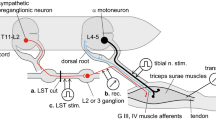Abstract
Stimulation of the perivascular nerves elicited two types of electrical responses in the rat tail artery—excitatory junction potentials (e.j.p.s) and slow depolarization—and two types of mechanical responses—fast and slow contractions. Fast phasic contractions were triggered whenever action potentials were generated from either the e.j.p. or the slow depolarization reaching threshold. Slow tonic contractions and slow depolarizations were sensitive to α-adrenergic blockade. However the slow contraction always preceded the slow depolarization. Bolus doses of exogenous noradrenaline also induced slow contraction and slow depolarization and the development of tension also preceded the membrane potential change. Increasing the external KCl also induced membrane depolarization however, contractions were not observed until the membrane was depolarized positive of −49 mV. In contrast, tension developed readily with membrane potential more negative than −49 mV with exogenous noradrenaline and neural stimulation, suggesting that the action of noradrenaline was not mediated by electromechanical coupling. It was concluded that vascular activity in the rat tail artery could be regulated by the e.j.p., the slow depolarization and also by pharmacomechanical coupling.
Similar content being viewed by others
References
Bevan, J.A., Su, C. (1971). Distribution theory of resistance of neurogenic vasoconstriction to alphareceptor blockade in the rabbit. Circ. Res. 28, 179–187.
Cheung, D.W. (1982a). Two components in the cellular response of rat tail arteries to nerve stimulation. J. Physiol. 328, 461–468.
Cheung, D.W. (1982b). Spontaneous and evoked excitatory junction potentials in rat tail arteries. J. Physiol. 218, 449–459.
Hirst, G.D.S., Neild, T.O. (1980). Evidence for two populations of excitatory receptors for noradrenaline on arteriolar smooth muscle. Nature (Lond.) 283, 767–768.
Holman, M.E., Surprenant, A.M. (1980). An electrophysiological analysis of the effects of noradrenaline and α-receptor antagonists on neuromuscular transmission in mammalian muscular arteries. Br. J. Pharmac. 71, 651–661.
Mekata, F. (1980). Electrophysiological properties of the smooth muscle cell membrane of the dog coronary artery. J. Physiol. 298, 205–212.
Mekata, F., Niu, H. (1972). Biophysical effects of adrenaline on the smooth muscle of the rabbit common carotid artery. J. Gen. Physiol. 59, 92–102.
Mulvany, M.J., Nilsson, H., Flatman, J.A. (1982). Role of membrane potential in the response of rat small mesenteric arteries to exogenous noradrenaline stimulation. J. Physiol. 332, 363–373.
Author information
Authors and Affiliations
Rights and permissions
About this article
Cite this article
Cheung, D.W. Neural regulation of electrical and mechanical activities in the rat tail artery. Pflugers Arch. 400, 335–337 (1984). https://doi.org/10.1007/BF00581570
Received:
Accepted:
Issue Date:
DOI: https://doi.org/10.1007/BF00581570




